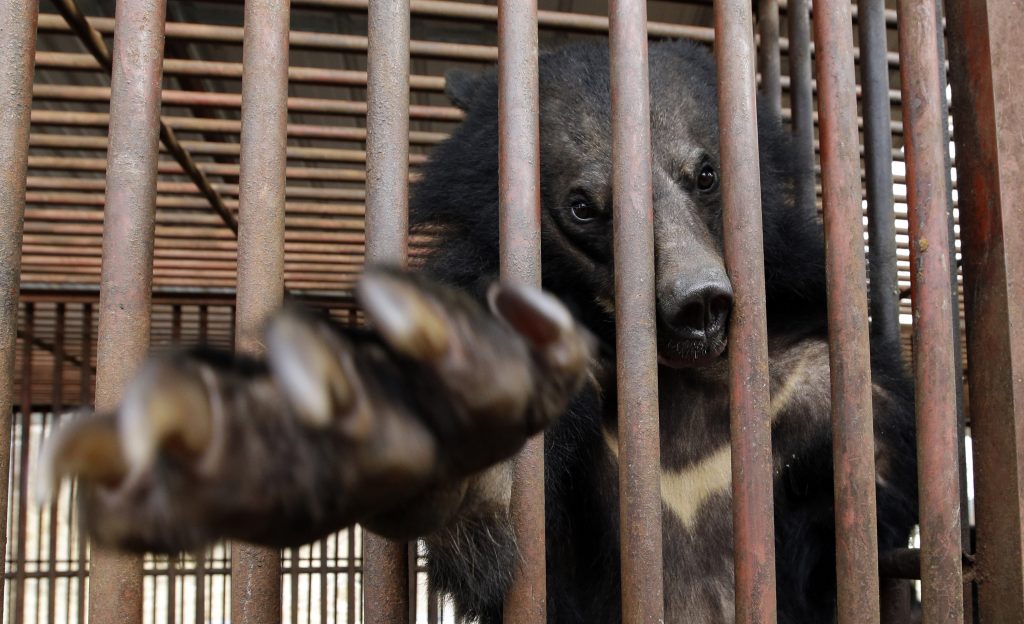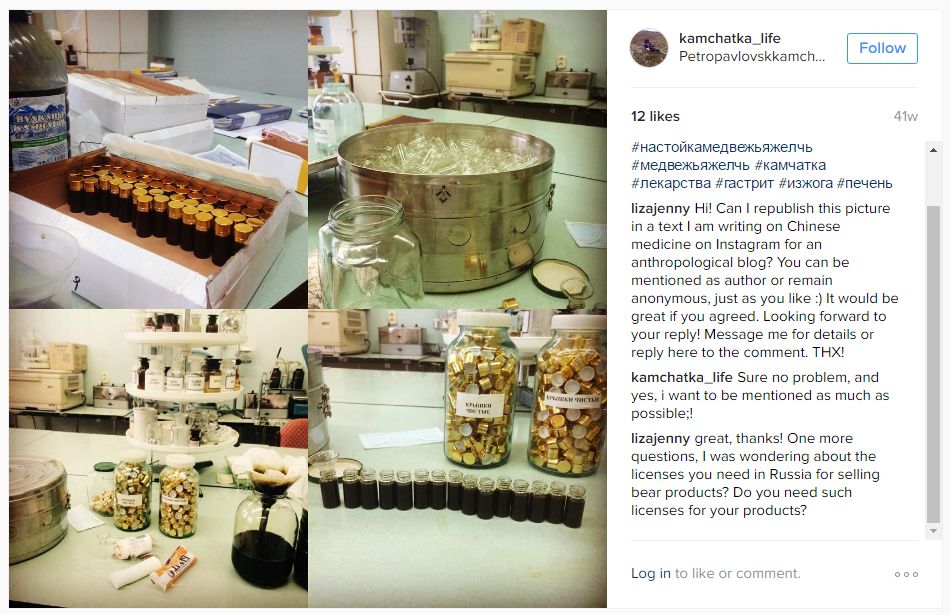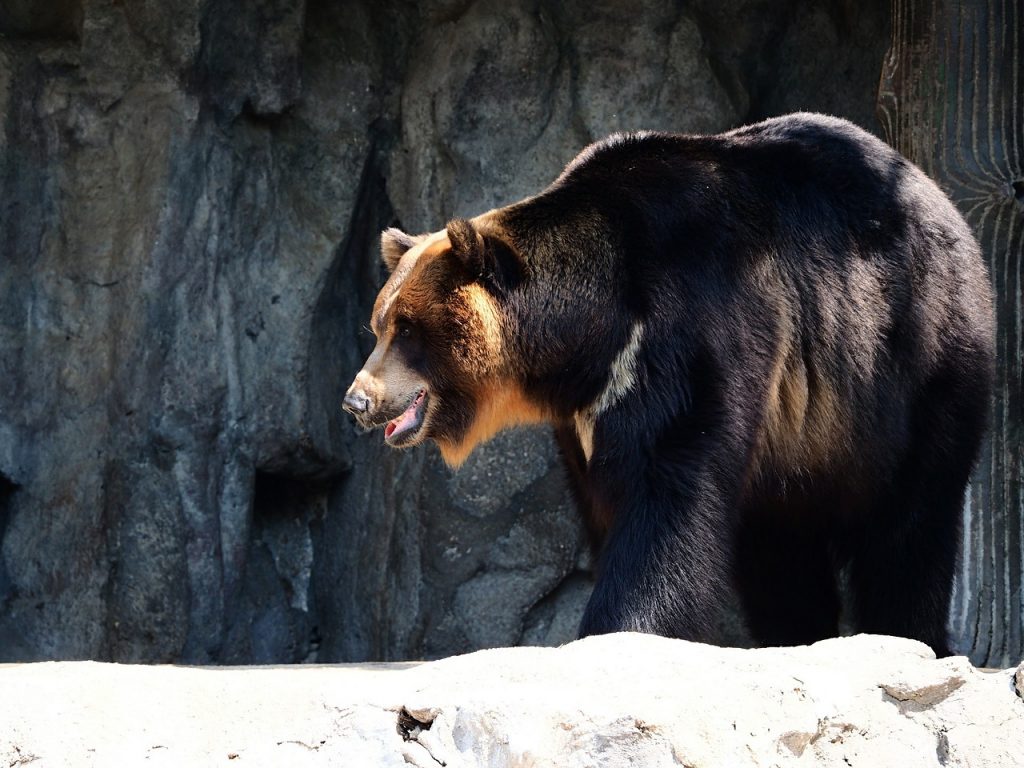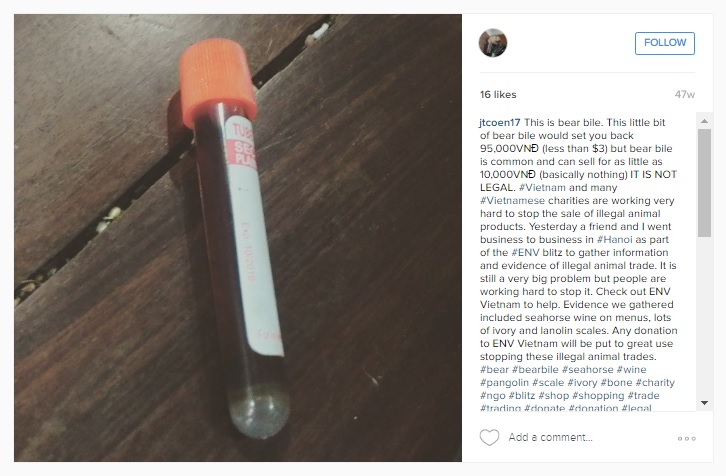On Instagram, a Journey From Bear to Bile

A huge, majestic black bear stands on a snow-covered rock. It is a moon bear, or Asiatic black bear. It has black fur with a crescent-shaped yellow patch on its chest, big furry ears, and gigantic paws. The Instagram photo of this bear has the hashtags #wildlife and #supportanimals, and it was uploaded by the user “animalgram.info.” A click on the account shows that this is a nature lover who relates to the bear out of an admiration for animals.
Another photo on Instagram reveals an entirely different side of a moon bear’s life: It shows a laboratory in Russia’s Kamchatka Peninsula, with flasks and rows of little bottles holding bear bile and other tinctures. The bear has been reduced to a medicine and an economic boon. The bear itself is absent from this picture, but it appears as a corpse in some of the user’s upbeat posts of hunting trips. Embedded in photos of a family business and local tourism, the transition of the bear from animal to product is visible in this account.
Instagram is an online social networking site where users can share photos and videos. It is primarily used by young people to share their mostly happy lives. But as an anthropologist, I have found that Instagram offers a fascinating window into the bloody—and mostly illegal—trade in endangered animals and animal parts. The platform makes visible a considerable amount of information about people that can be studied by researchers. Considering the sensitivity of information surrounding the animal trade, Instagram provides an unrivaled source of easily accessible, deep anthropological insight.
By tracing Instagram photos, user accounts, hashtags, and descriptions, one can observe an array of cultural worlds in which animals are admired, pitied, killed, dismembered, packaged, sold, bought, consumed, or rescued. The users are speaking to a variety of audiences, from potential customers to enraged observers. Aside from the wildlife photo of the moon bear, one can see a photo of a caged bear who has been tapped for bile extraction, which was posted by an animal rights activist; photos of bear bile and gallbladder products for sale in Russia, Indonesia, and Vietnam displayed by proud business owners or activists; and a photo of a rescued bear posted by a journalist.
Animal trafficking is among the top five illegal trades worldwide. It is close behind the illegal trades in drugs, counterfeits, and human trafficking in terms of financial volume, and it has been estimated by the London-based International Fund for Animal Welfare (IFAW) to have a yearly turnover of US$19 billion. Endangered species and animal parts are sold in the tens of thousands as exotic pets, food, materials in clothing and accessories, and ingredients for traditional medicine. The major supply regions for a number of the biggest illicit animal markets are Southeast Asia and sub-Saharan Africa, with animals and animal products primarily destined for markets in China, the European Union, and the United States. The demand for wildlife, including endangered species regulated by the Convention on International Trade in Endangered Species of Wild Fauna and Flora (CITES), is growing.
The internet is central to facilitating this trade. Endangered animals and animal parts that fall under CITES’ regulations are often sold illegally online in marketplaces such as Etsy, in closed Facebook groups and in Instagram auctions, as well as on auction websites such as eBay. Sometimes code words are used to disguise the illegal sale, but posts typically are explicit. A 2014 study conducted by IFAW over a six-week period on 280 online marketplaces in 16 countries found 9,482 advertisements selling a total of 33,006 endangered wildlife products—both live and dead animals as well as parts—that are listed as protected by CITES. The estimated value of these advertisements was around US$11 million.
It is extremely hard to police this activity; given the complexity of international trade laws and certifications, it is nearly impossible to tell if products advertised online are legal, illegal, or even a hoax. Regulations are rarely enforced. But the nongovernmental organization TRAFFIC does monitor wildlife trade networks, including several websites, and frequently exposes selling practices that exist in online media. The organization also cooperates with platforms such as eBay to manage this problem. As a result, for example, eBay banned ivory trading on its site in 2007.
The internet can do more than just facilitate trade or expose illegal sales. It can also shed light on where this trade takes place, which countries it connects globally, who the clients and producers are, and in which social worlds their actions are embedded. A picture on Instagram is part of a bigger story.
Take, for example, this Instagram photo showing a disfigured bear in a tiny crash cage, which is used to keep the bear still while bile is tapped from its gallbladder. Most of the bear’s dark fur is gone. It has wounds over its legs and a hole in its belly. The post contains the hashtags #bearbilefarming, #killing, #China, and #Vietnam, and it was uploaded by the user “msg2humanity,” apparently an activist for animal rights. Though totally different in emotional content from the photo of the bear on the snowy rock, it has something in common with it: Both photos embed bears in a discourse of environmentalism and show them as worthy of human admiration and protection.
Animal trafficking is among the top five illegal trades worldwide.
Another photo I found shows three wrinkly black lumps against off-white backgrounds. They are dried bear gallbladders, one or two of which are from Asiatic black bears, used as herbal remedies in traditional Chinese medicine. This combination of photos was uploaded by Po Ho Seng, a store for traditional Chinese medicine geotagged in Jakarta, Indonesia. The store’s other posts show additional medicinal products, among other items. The picture is tagged with #熊胆, Chinese for bear bile, and with #Traditional, #Chinese, #Medicine, and other indicators of this type of medicine: #中医 and #zhongyao. In these images, the gallbladders are now objects in their own right, separate from the bear, with medicinal function and economic value. It is unclear whether the company holds any licenses permitting the trade of these products. After I asked this user about the images, the user blocked me, so I am no longer able to access this account.
Photos that show bear bile for sale in little phials and flasks go a step further, removing the bile from the idea of a bear altogether. The user “china.store,” self-described as a shop in Russia for Chinese medicine, posts a variety of traditional Chinese medicine products, many of them connected to health, beauty, and improving one’s sex life. Based on their posts, it appears that bear bile is just one of many products associated with a lifestyle of health, beauty, and traditional medicine. The mood is upbeat.
The same is true for the photo from the Kamchatka Peninsula. That account user, “kamchatka_life,” is aiming their posts at a Russian-speaking alternative medicine audience, with hashtags such as #настойкамедвежьяжелчь (bear bile tincture). The user seems to stand behind the use of bears for creating these products and is clearly proud of his business: When I asked if SAPIENS could reprint the photo, he replied: “Sure no problem, and yes, i want to be mentioned as much as possible!”
Another picture showing bear bile in a little phial found in a Vietnamese market has a different tone. This one was uploaded by a person who describes herself as an English teacher living in Hanoi. Her other posts show pictures from her personal life: the city, her cat, herself, and friends. The photograph of the bear bile phial is tagged with hashtags such as #bearbile, #trade, #donate, #illegal, and #envvietnam. The user asks people to help fight the illegal animal trade and donate to the organization ENV Vietnam. For her, the existence of this phial of medicine is proof of a bear’s suffering and of environmental crime.
Yet another image features the snout of a moon bear, upside down, with its tongue hanging out. He is sedated—a rescued bear on his way to a sanctuary. This has been posted by a self-described journalist and traveler, whose username is “haudtt.” His other posts show beautiful photographs from Asia: landscapes, people, and food. The picture of the sedated bear is tagged with #endbearbile, #ig_vietnam, #weeklyfluff, #instagood, and many other hashtags. These show support for animal rights as well as the user’s participation in Instagram’s photography culture. The bear is whole again and has been incorporated into a story with a happy ending to cheer up the Instagram community.
Instagram offers visual and cultural glimpses behind the curtain of a trade that usually takes place in obscurity. By documenting these photos and the attitudes behind them, we can track trade routes, the fluidity of local laws, and the transformation of animals into products. More importantly, this documentation enriches our knowledge of the animal trade, adding context to the story and painting producers and clients as more than just one-dimensional actors.
Instagram makes worlds of knowledge available for those with access to it: knowledge that can be repurposed to trace the steps of the bear, document humankind’s responses, and ultimately to fight crime.




























